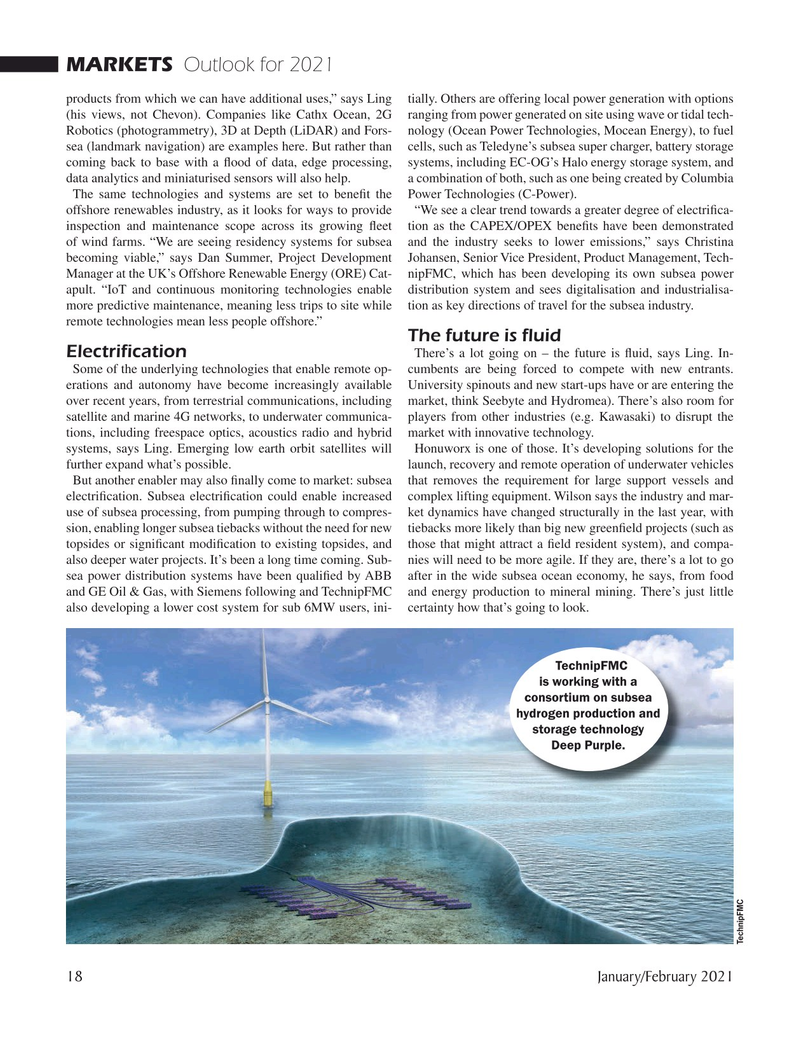
Page 18: of Marine Technology Magazine (January 2021)
Underwater Vehicle Annual
Read this page in Pdf, Flash or Html5 edition of January 2021 Marine Technology Magazine
MARKETS Outlook for 2021 products from which we can have additional uses,” says Ling tially. Others are offering local power generation with options (his views, not Chevon). Companies like Cathx Ocean, 2G ranging from power generated on site using wave or tidal tech-
Robotics (photogrammetry), 3D at Depth (LiDAR) and Fors- nology (Ocean Power Technologies, Mocean Energy), to fuel sea (landmark navigation) are examples here. But rather than cells, such as Teledyne’s subsea super charger, battery storage coming back to base with a ? ood of data, edge processing, systems, including EC-OG’s Halo energy storage system, and data analytics and miniaturised sensors will also help. a combination of both, such as one being created by Columbia
The same technologies and systems are set to bene? t the Power Technologies (C-Power). offshore renewables industry, as it looks for ways to provide “We see a clear trend towards a greater degree of electri? ca- inspection and maintenance scope across its growing ? eet tion as the CAPEX/OPEX bene? ts have been demonstrated of wind farms. “We are seeing residency systems for subsea and the industry seeks to lower emissions,” says Christina becoming viable,” says Dan Summer, Project Development Johansen, Senior Vice President, Product Management, Tech-
Manager at the UK’s Offshore Renewable Energy (ORE) Cat- nipFMC, which has been developing its own subsea power apult. “IoT and continuous monitoring technologies enable distribution system and sees digitalisation and industrialisa- more predictive maintenance, meaning less trips to site while tion as key directions of travel for the subsea industry. remote technologies mean less people offshore.”
The future is fluid
Electrification There’s a lot going on – the future is ? uid, says Ling. In-
Some of the underlying technologies that enable remote op- cumbents are being forced to compete with new entrants. erations and autonomy have become increasingly available University spinouts and new start-ups have or are entering the over recent years, from terrestrial communications, including market, think Seebyte and Hydromea). There’s also room for satellite and marine 4G networks, to underwater communica- players from other industries (e.g. Kawasaki) to disrupt the tions, including freespace optics, acoustics radio and hybrid market with innovative technology. systems, says Ling. Emerging low earth orbit satellites will Honuworx is one of those. It’s developing solutions for the further expand what’s possible. launch, recovery and remote operation of underwater vehicles
But another enabler may also ? nally come to market: subsea that removes the requirement for large support vessels and electri? cation. Subsea electri? cation could enable increased complex lifting equipment. Wilson says the industry and mar- use of subsea processing, from pumping through to compres- ket dynamics have changed structurally in the last year, with sion, enabling longer subsea tiebacks without the need for new tiebacks more likely than big new green? eld projects (such as topsides or signi? cant modi? cation to existing topsides, and those that might attract a ? eld resident system), and compa- also deeper water projects. It’s been a long time coming. Sub- nies will need to be more agile. If they are, there’s a lot to go sea power distribution systems have been quali? ed by ABB after in the wide subsea ocean economy, he says, from food and GE Oil & Gas, with Siemens following and TechnipFMC and energy production to mineral mining. There’s just little also developing a lower cost system for sub 6MW users, ini- certainty how that’s going to look.
TechnipFMC is working with a consortium on subsea hydrogen production and storage technology
Deep Purple.
TechnipFMC 18 January/February 2021
MTR #1 (18-33).indd 18 1/25/2021 9:03:32 AM

 17
17

 19
19
